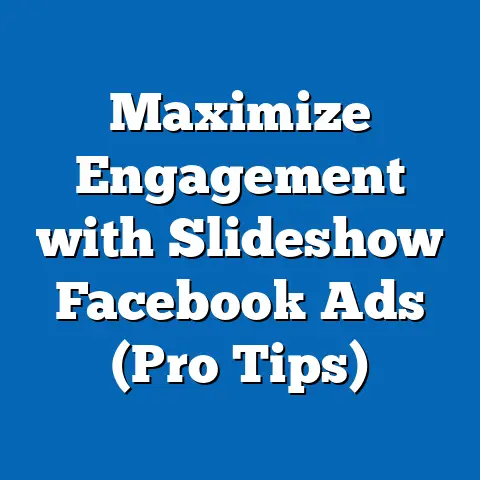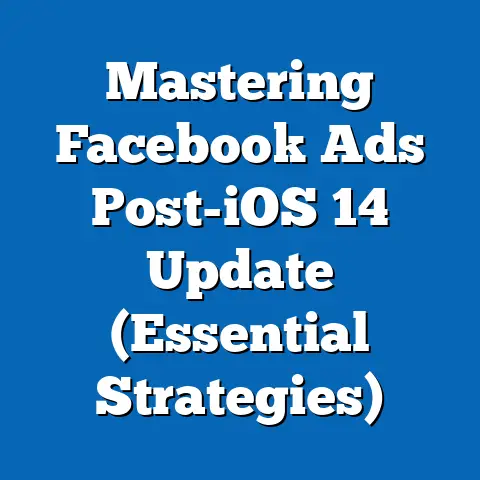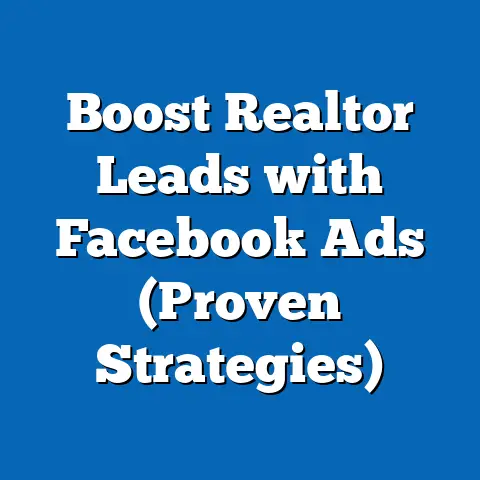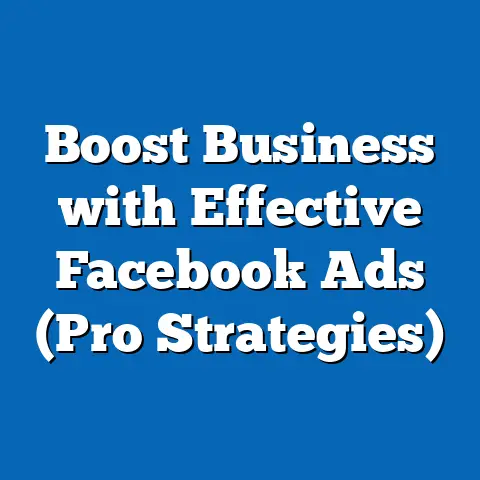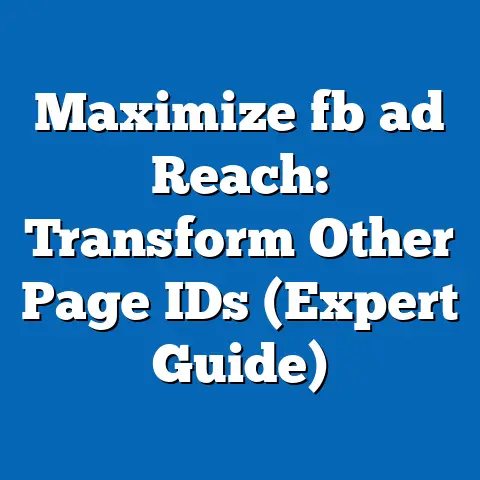Unlock Facebook Ad Mastery (Pro Tips for Impactful Campaigns)
Have you ever heard the story of Daedalus and Icarus? Daedalus, a master craftsman, built wings of feathers and wax for himself and his son, Icarus, to escape imprisonment. He warned Icarus not to fly too close to the sun, but Icarus, intoxicated by the freedom of flight, ignored his father’s advice. The wax melted, the wings disintegrated, and Icarus plummeted to his doom.
This ancient tale echoes in the world of Facebook advertising. Just like Daedalus’s carefully crafted wings, a well-structured Facebook ad campaign can lift your business to incredible heights. But like Icarus’s recklessness, a lack of knowledge and strategy can lead to a devastating fall. The key? Mastering the art and science of Facebook ads. This guide is your Daedalus, providing you with the tools and knowledge to navigate the complexities of Facebook advertising and soar to success.
The Importance of Facebook Ads in Today’s Digital Landscape
Facebook isn’t just a social media platform; it’s a digital marketing powerhouse. With billions of active users worldwide, it offers unparalleled reach and targeting capabilities for businesses of all sizes. In fact, as of 2024, Facebook boasts over 3 billion monthly active users, making it the most popular social media platform globally. This massive audience presents a golden opportunity for businesses to connect with potential customers and drive conversions.
I’ve seen firsthand how a well-executed Facebook ad campaign can transform a struggling business into a thriving one. I remember working with a local bakery that was struggling to attract new customers. We crafted a targeted Facebook ad campaign featuring mouthwatering photos of their pastries, targeting users interested in baking, desserts, and local food. The results were astounding. Within weeks, the bakery saw a significant increase in foot traffic and online orders, ultimately boosting their revenue by 40%.
The beauty of Facebook ads lies in their precision. Unlike traditional advertising methods, Facebook allows you to target your ideal audience based on demographics, interests, behaviors, and even life events. This means you can reach the people who are most likely to be interested in your products or services, maximizing your advertising ROI.
For instance, let’s say you’re selling organic baby food. With Facebook ads, you can target parents of young children who are interested in organic products, healthy eating, and parenting blogs. This level of granularity ensures that your ad dollars are spent wisely, reaching the right people at the right time.
Key Takeaway: Facebook ads are essential for businesses seeking to expand their reach, connect with their ideal audience, and drive conversions in today’s digital landscape.
Understanding the Facebook Ads Ecosystem
The Facebook Ads ecosystem can seem daunting at first, but once you understand the key components, it becomes much more manageable. Let’s break it down.
Different Ad Types:
- Image Ads: These are the simplest and most common type of Facebook ad. They feature a single image or video along with ad copy and a call to action. They are great for showcasing products and services visually.
- Video Ads: Video ads are highly engaging and can be used to tell stories, demonstrate product features, or share testimonials. They are particularly effective for capturing attention in a crowded newsfeed.
- Carousel Ads: Carousel ads allow you to showcase multiple images or videos in a single ad unit. They are ideal for highlighting different aspects of a product or service, or for telling a sequential story.
- Collection Ads: Collection ads are designed for e-commerce businesses. They feature a hero image or video along with a selection of products that users can browse and purchase directly from the ad.
- Lead Ads: Lead ads are specifically designed to generate leads. They allow users to submit their contact information directly from the ad, without having to visit a landing page.
The Ad Auction System:
Facebook uses an ad auction system to determine which ads are shown to users. This system takes into account several factors, including:
- Bid Amount: This is the amount you’re willing to pay for each click or impression.
- Relevance Score: This is a measure of how relevant your ad is to your target audience.
- Estimated Action Rates: This is Facebook’s prediction of how likely users are to take action after seeing your ad.
- Ad Quality: Facebook assesses the quality of your ad based on factors like image quality, ad copy, and landing page experience.
The higher your bid and relevance score, the more likely your ad is to win the auction and be shown to users. This is why it’s crucial to create high-quality, relevant ads that resonate with your target audience.
I’ve learned that understanding the ad auction is half the battle. I once worked with a client who was frustrated with their ad performance. They were bidding aggressively but still weren’t seeing results. After analyzing their campaigns, I realized that their ads were poorly targeted and lacked compelling creative. By refining their targeting and creating more engaging ads, we were able to significantly improve their relevance score and win more auctions, ultimately driving down their cost per acquisition.
Key Takeaway: Understanding the Facebook Ads ecosystem, including the different ad types and the ad auction system, is crucial for creating effective campaigns.
Crafting Compelling Ad Copy and Creative
Your ad copy and creative are the first things users see, so it’s crucial to make a strong impression. Here are some pro tips for crafting compelling ad copy and visuals:
Headlines That Grab Attention:
- Use Numbers and Statistics: Numbers are attention-grabbing and can add credibility to your message. For example, “5 Proven Ways to Increase Your Website Traffic.”
- Ask a Question: Questions pique curiosity and encourage users to click. For example, “Are You Making These Common Marketing Mistakes?”
- Use Power Words: Power words are emotionally charged words that can evoke a strong response. For example, “Discover,” “Unlock,” “Transform.”
- Keep it Concise: Aim for headlines that are short, sweet, and to the point.
Compelling Ad Descriptions:
- Highlight the Benefits: Focus on the benefits of your product or service, rather than just the features.
- Tell a Story: Stories are engaging and can help users connect with your brand on an emotional level.
- Create a Sense of Urgency: Use words like “Limited Time Offer” or “Act Now” to encourage users to take action.
- Use Social Proof: Include testimonials or reviews to build trust and credibility.
Effective Calls to Action:
- Be Clear and Specific: Tell users exactly what you want them to do.
- Use Action-Oriented Language: Use verbs like “Shop Now,” “Learn More,” “Sign Up.”
- Create a Sense of Value: Explain what users will get by clicking on your call to action.
- Test Different Calls to Action: Experiment with different calls to action to see which ones perform best.
Visuals That Resonate:
- Use High-Quality Images and Videos: Make sure your visuals are clear, sharp, and visually appealing.
- Align Visuals with Messaging: Your visuals should reinforce your ad copy and create a cohesive brand experience.
- Use Eye-Catching Colors: Use colors that are consistent with your brand and that stand out in the newsfeed.
- Test Different Visuals: Experiment with different images and videos to see which ones resonate best with your target audience.
I’ve found that A/B testing is invaluable when it comes to crafting compelling ad copy and creative. I once worked with an e-commerce client who was struggling to improve their click-through rates. We created two versions of their ad, one with a benefit-driven headline and the other with a question-based headline. The question-based headline outperformed the benefit-driven headline by a significant margin, ultimately leading to a 30% increase in click-through rates.
Key Takeaway: Crafting compelling ad copy and creative is essential for capturing attention, conveying your message, and driving conversions.
Targeting Your Ideal Audience
Facebook’s targeting capabilities are incredibly powerful, allowing you to reach your ideal audience with laser precision. Here are some advanced targeting strategies to consider:
Custom Audiences:
Custom Audiences allow you to target users who have already interacted with your business. You can create Custom Audiences based on:
- Website Traffic: Target users who have visited your website.
- Email List: Upload your email list to target your existing customers.
- Mobile App Activity: Target users who have downloaded and used your mobile app.
- Engagement on Facebook: Target users who have liked your page, watched your videos, or interacted with your posts.
Lookalike Audiences:
Lookalike Audiences allow you to target users who are similar to your existing customers. You can create Lookalike Audiences based on:
- Custom Audiences: Use your Custom Audiences as a seed audience to find users who share similar characteristics.
- Page Fans: Use your Facebook page fans as a seed audience to find users who are likely to be interested in your brand.
Interest-Based Targeting:
Interest-based targeting allows you to target users based on their interests, hobbies, and activities. You can target users interested in specific topics, brands, or even celebrities.
Behavioral Targeting:
Behavioral targeting allows you to target users based on their online behavior, such as their purchase history, travel habits, and device usage.
Segmentation:
Segmentation involves dividing your target audience into smaller, more homogeneous groups based on shared characteristics. This allows you to create tailored ad campaigns that resonate with each segment.
For example, if you’re selling fitness equipment, you might segment your audience based on their fitness goals (e.g., weight loss, muscle gain, general fitness). You can then create ad campaigns that specifically address the needs and interests of each segment.
I’ve learned that effective segmentation can significantly improve ad performance. I once worked with a clothing retailer who was struggling to generate sales through Facebook ads. After analyzing their customer data, we segmented their audience based on age, gender, and style preferences. We then created tailored ad campaigns for each segment, featuring clothing that was relevant to their individual tastes. As a result, their sales increased by 60%.
Key Takeaway: Advanced targeting strategies, such as Custom Audiences, Lookalike Audiences, and segmentation, are essential for reaching your ideal audience and maximizing your advertising ROI.
Monitoring and Optimizing Ad Performance
Monitoring and optimizing your ad performance is an ongoing process that requires careful attention to detail. Here are some key metrics to track and how to interpret them:
Impressions: The number of times your ad is shown to users. This metric indicates the reach of your ad.
Click-Through Rate (CTR): The percentage of users who click on your ad after seeing it. A high CTR indicates that your ad is relevant and engaging.
Conversion Rate: The percentage of users who take a desired action after clicking on your ad (e.g., making a purchase, signing up for a newsletter). A high conversion rate indicates that your landing page is effective and that your offer is compelling.
Cost Per Acquisition (CPA): The cost of acquiring a new customer through your ad campaign. A low CPA indicates that your campaign is efficient and cost-effective.
Return on Ad Spend (ROAS): The amount of revenue generated for every dollar spent on advertising. A high ROAS indicates that your campaign is profitable.
Interpreting Metrics:
- Low Impressions: This could indicate that your targeting is too narrow or that your bid amount is too low.
- Low CTR: This could indicate that your ad copy and creative are not compelling or that your targeting is not relevant.
- Low Conversion Rate: This could indicate that your landing page is not optimized or that your offer is not compelling.
- High CPA: This could indicate that your campaign is not efficient or that your targeting is not accurate.
- Low ROAS: This could indicate that your campaign is not profitable or that your product or service is not appealing.
Using Facebook Analytics and Ads Manager:
Facebook Analytics and Ads Manager provide a wealth of data and insights that can help you monitor and optimize your ad performance. These tools allow you to:
- Track key metrics in real-time.
- Analyze audience demographics and behavior.
- Identify areas for improvement.
- A/B test different ad variations.
- Adjust your campaigns based on performance data.
I’ve found that ongoing testing and optimization are crucial for maximizing ad performance. I once worked with a client who was seeing a decent ROAS but wanted to improve it further. We ran a series of A/B tests, experimenting with different ad copy, creative, and targeting options. After several weeks of testing, we discovered that a specific combination of ad copy and targeting resulted in a 40% increase in ROAS.
Key Takeaway: Monitoring and optimizing your ad performance is an ongoing process that requires careful attention to detail and a willingness to experiment.
Staying Ahead of the Curve with Facebook Ads
The world of Facebook advertising is constantly evolving, with new features, trends, and best practices emerging all the time. To stay ahead of the curve, it’s essential to stay updated with the latest developments.
Engage with Industry Blogs and Webinars:
- Social Media Examiner: This blog covers a wide range of social media marketing topics, including Facebook advertising.
- AdEspresso: This blog focuses specifically on Facebook advertising and offers a wealth of practical advice.
- Jon Loomer Digital: This blog is run by a Facebook advertising expert and provides in-depth analysis and strategies.
Follow Facebook’s Own Resources:
Facebook provides a wealth of resources for advertisers, including:
- Facebook Business Help Center: This is a comprehensive resource that covers all aspects of Facebook advertising.
- Facebook Marketing Partners: This is a directory of trusted partners who can help you with your Facebook advertising efforts.
- Facebook for Business Blog: This blog features news, tips, and best practices for Facebook advertising.
Emerging Trends:
- AI-Powered Ad Targeting: Facebook is increasingly using AI to improve ad targeting and personalization.
- Augmented Reality (AR) Ads: AR ads allow users to interact with your products in a virtual environment.
- Video-First Advertising: Video is becoming increasingly important in Facebook advertising.
I believe that the future of Facebook advertising lies in personalization and automation. As AI technology continues to advance, we’ll see more sophisticated targeting and ad creation tools that allow us to deliver highly relevant and engaging experiences to users.
Key Takeaway: Staying updated with the latest features, trends, and best practices is essential for maximizing your Facebook advertising success.
Conclusion
Mastering Facebook ads is not a destination, but a journey. Like Icarus, you need the right tools and knowledge to soar to great heights. But unlike Icarus, you need to heed the warnings and stay grounded in data and strategy. By understanding the Facebook Ads ecosystem, crafting compelling ad copy and creative, targeting your ideal audience, monitoring and optimizing your ad performance, and staying ahead of the curve, you can unlock your own Facebook ad mastery and achieve your business goals. So, take flight, experiment, and never stop learning. The sky’s the limit!

